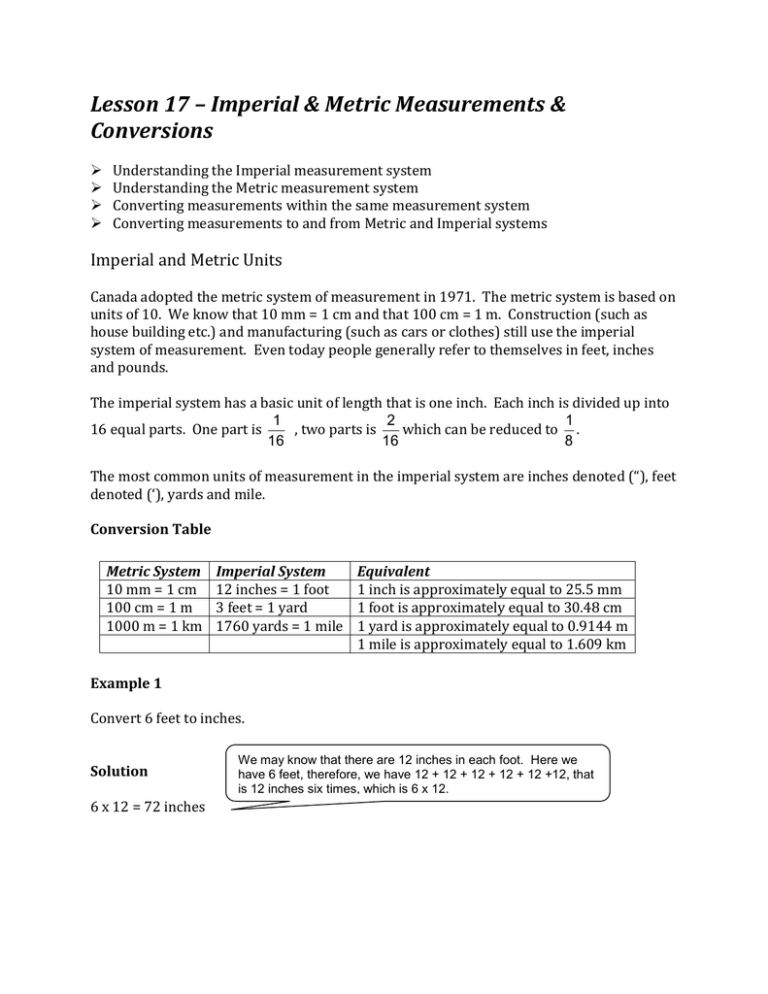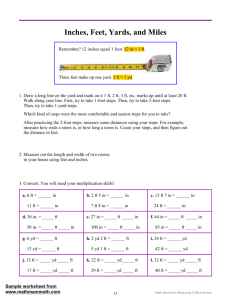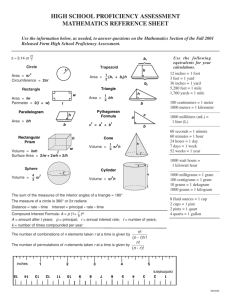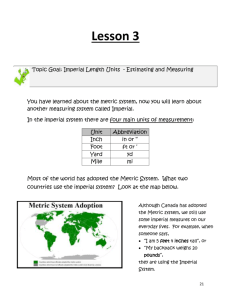Lesson 17 – Imperial & Metric Measurements & Conversions.DOC
advertisement

Lesson 17 – Imperial & Metric Measurements & Conversions Understanding the Imperial measurement system Understanding the Metric measurement system Converting measurements within the same measurement system Converting measurements to and from Metric and Imperial systems Imperial and Metric Units Canada adopted the metric system of measurement in 1971. The metric system is based on units of 10. We know that 10 mm = 1 cm and that 100 cm = 1 m. Construction (such as house building etc.) and manufacturing (such as cars or clothes) still use the imperial system of measurement. Even today people generally refer to themselves in feet, inches and pounds. The imperial system has a basic unit of length that is one inch. Each inch is divided up into 1 2 1 16 equal parts. One part is , two parts is which can be reduced to . 16 16 8 The most common units of measurement in the imperial system are inches denoted (“), feet denoted (‘), yards and mile. Conversion Table Metric System 10 mm = 1 cm 100 cm = 1 m 1000 m = 1 km Imperial System 12 inches = 1 foot 3 feet = 1 yard 1760 yards = 1 mile Equivalent 1 inch is approximately equal to 25.5 mm 1 foot is approximately equal to 30.48 cm 1 yard is approximately equal to 0.9144 m 1 mile is approximately equal to 1.609 km Example 1 Convert 6 feet to inches. Solution 6 x 12 = 72 inches We may know that there are 12 inches in each foot. Here we have 6 feet, therefore, we have 12 + 12 + 12 + 12 + 12 +12, that is 12 inches six times, which is 6 x 12. Example 2 Convert 500 metres to kilometres Solution We know that there are 1000 metres in a kilometre, so 500 m is half of 1000, therefore it is half of a kilometre. 500 1000 0.5 km People sometimes have difficulties converting to and from Metric to Imperial systems . Below is an example of a useful chart to help with conversions. KNOW and NEED chart Let us consider our first example of converting 6 feet to inches. The first step is to put the units you are working with in the chart. It doesn’t matter which one you write first as long as they appear in the centre column of the chart Next we fill in what we know in the “KNOW” column of the chart. We know 1 foot has 12 inches. Then in the “NEED” column we can put a 6 beside the feet because that is in the question and a ? beside the inches because that is what is being asked to find. The chart represents to equal fractions. 1 6 under the “know” heading and under the 12 ? “need” heading. Finally to find “?” we cross multiply to find the solution to our question. Therefore there are 72 inches in 6 feet. Example 3 Convert 454 feet to yards. Solution Therefore is there is approximately 151.3 yard in 454 feet. Example 4 How many inches are in 300 mm? Solution Therefore there are approximately 11.76 inches in 300 mm. Homework Questions 1. Find the area of the triangle in imperial and metric units. Part II 2. How many millimetres would represent 14 inches? 3. How many miles would be equal to 3 km? Part III 1. Convert the following: a. 36 inches to millimetres b. 1400 feet to centimetres 2. Find the perimeter in Imperial units and the area in Metric units. a. a square with sides 5 yards long b. 3. You are giving an older friend directions to your cottage. You say that it is 325 km to the cottage. The friend knows they can go 60km/hr. How long will it take them to get to the cottage? 4. You tell your older friend that it is 100 metres across the bay. They want to know how many feet that is. 5. Your older friend calls you and says they have a 6 yard by 6 yard tarp they can bring to cover an open area at your cottage. You know the area of the picnic tables to be tarped is 48 metres squared. Should your friend bother to bring their tarp because it is too small?




